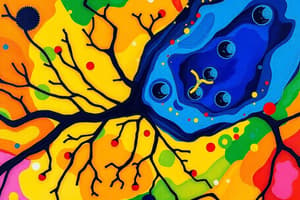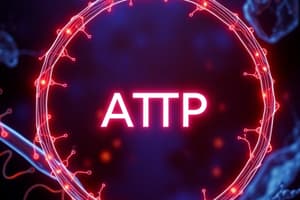Podcast
Questions and Answers
Which organelle is known as the powerhouse of the cell?
Which organelle is known as the powerhouse of the cell?
- Mitochondrion (correct)
- Golgi apparatus
- Nucleus
- Endoplasmic reticulum
This also known as CMTA
This also known as CMTA
- Ra 10863 (correct)
- Pd 10863
- Ra 10683
- Genetic RA 10386
Which molecule is produced by the powerhouse to store and supply energy?
Which molecule is produced by the powerhouse to store and supply energy?
- ATP (correct)
- RNA
- Protein
- DNA
In what type of cells would you expect to find a high number of mitochondria?
In what type of cells would you expect to find a high number of mitochondria?
What process occurs in the 'powerhouse' of the cell?
What process occurs in the 'powerhouse' of the cell?
Flashcards
Mitochondrion
Mitochondrion
Organelle responsible for energy production (ATP) in eukaryotic cells.
Cellular Respiration
Cellular Respiration
Process by which glucose is broken down to generate energy (ATP) in cells.
ATP (Adenosine Triphosphate)
ATP (Adenosine Triphosphate)
Energy currency of the cell; provides energy for cellular processes.
Krebs Cycle (Citric Acid Cycle)
Krebs Cycle (Citric Acid Cycle)
Signup and view all the flashcards
Electron Transport Chain (ETC)
Electron Transport Chain (ETC)
Signup and view all the flashcards
Study Notes
- Mitochondria are known as the powerhouse of the cell
- Mitochondria are membrane-bound cell organelles (mitochondrion, singular) that generate most of the chemical energy needed to power the cell’s biochemical reactions
- Chemical energy produced by the mitochondria is stored in a small molecule called adenosine triphosphate (ATP)
- Mitochondria contain their own small chromosomes
- They reproduce independently of the cell through asexual reproduction
- The number of mitochondria in a cell depends on the cell type
- Many cells have hundreds or even thousands of mitochondria
- Other cells, such as mature red blood cells, do not contain any mitochondria
Structure
- A mitochondrion has two membranes: an outer membrane and an inner membrane
- These membranes have different characteristics
- The outer membrane is quite porous, allowing the passage of molecules about 5000 Daltons in size or less
- The inner membrane is much more selective, allowing only specific molecules to pass through it
- Transport proteins assist in moving molecules across the inner membrane
- The inner membrane is folded into numerous cristae, which increase the surface area inside the organelle
- Mitochondria also have two compartments: the intermembrane space, between the two membranes, and the matrix, which is inside the inner membrane
- The intermembrane space is where protons are accumulated for the generation of ATP by chemiosmosis
- The mitochondrial matrix contains the mitochondrial DNA, ribosomes, enzymes, and other molecules required for ATP production
Function
- The most important role of mitochondria is to produce energy
- They do this through a process called oxidative phosphorylation
- Oxidative phosphorylation involves the oxidation of molecules like glucose and fatty acids to produce ATP
- ATP is the main energy currency of the cell
- Mitochondria are also involved in other cellular processes, such as:
- Apoptosis (programmed cell death)
- Calcium signaling
- Regulation of the cell cycle
- Cellular differentiation
- Cell growth
- Mitochondria are dynamic organelles
- They can change their shape, size, and number depending on the needs of the cell
- They can also move around within the cell
- The shape of the mitochondria is determined by a balance between fusion and fission:
- Mitochondrial fusion: the fusion of two mitochondria into one
- Mitochondrial fission: the division of one mitochondrion into two
- Some diseases are caused by mutations in genes that are located in the mitochondria
- These diseases can affect any part of the body, but they often affect the brain, muscles, and heart
Studying That Suits You
Use AI to generate personalized quizzes and flashcards to suit your learning preferences.




